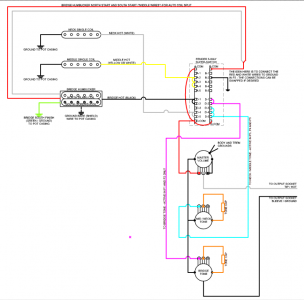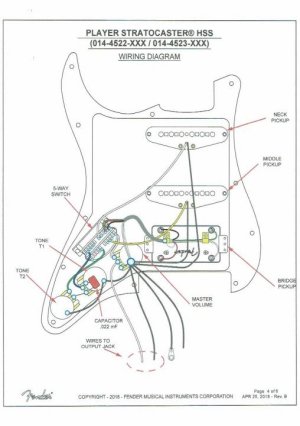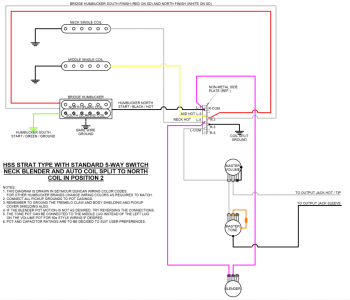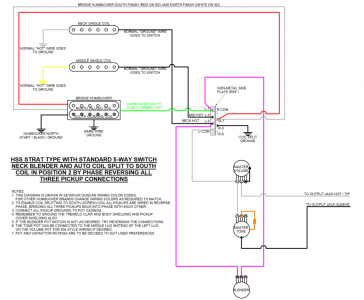Having just read all 3 parts of the very informative SD website article "5 Way Switch Explained" I am keen to add T2 tone control to my MIM HSS stratocaster at switch position 1. My dilemma is that standard humbucker and SSS wiring diagrams appear quite different and so it's not clear to me which lugs to jumper or even if it's possible to achieve what I want to do with the standard 5 way switch. In this regard, I note that the modern player series HSS strats have a 5 way "super switch" instead. Grateful if someone can advise what to connect to what so that I have full T2 tone control over both halves of the humbucker in position 1 while retaining T2 control of the split humbucker and middle pickup in position 2. Thanks, from Forum newbie Alan.
You are using an out of date browser. It may not display this or other websites correctly.
You should upgrade or use an alternative browser.
You should upgrade or use an alternative browser.
Tone Control for Bridge Humbucker
- Thread starter AlanB
- Start date
JB_From_Hell
Jomo's Nimions
Look at the switch, and where the tone controls are connected now. You need to jump the lug T2 is currently connected to with the one next to it.
eclecticsynergy
Well-known member
To be a little more specific, you need to move that wire from the lug where the middle pickup attaches, to the one where the bridge pickup attaches.
T2 will then be active in both position 1 and position 2.
Your guitar uses the standard 5-way and not a superswitch, right?
I'm assuming it looks like the diagram below (although the wire colors on your guitar might differ from this one).

You can see how the wire to T2 is attached to the same switch lug where the middle pickup (yellow wire, here) connects.
Red arrow points right at it.
You just need to move that wire over to where the lead pickup (green wire, here) attaches.
T2 will then be active in both position 1 and position 2.
Your guitar uses the standard 5-way and not a superswitch, right?
I'm assuming it looks like the diagram below (although the wire colors on your guitar might differ from this one).

You can see how the wire to T2 is attached to the same switch lug where the middle pickup (yellow wire, here) connects.
Red arrow points right at it.
You just need to move that wire over to where the lead pickup (green wire, here) attaches.
ThreeChordWonder
New member
My MIM HSS (2020) came with a superswitch.
T2 was already dedicated to the bridge humbucker. Which was also wired to self (auto) coil split in P2.
T2 was already dedicated to the bridge humbucker. Which was also wired to self (auto) coil split in P2.
ThreeChordWonder
New member
The wiring diagram eclecticsynergy posted uses the contacts on the left side of switch for pickup selection and tone assignments and uses the right side of switch contacts to auto coil split the bridge humbucker in P2.
The tones are connected to your choice of two out of the three pickup inputs. If you pit a jumper in the try and use one of the tones with two pickups, say middle and neck, you'll create a "short" so that both the middle and neck pickuos work in P2, P3, P4 and P5.
Instead, connect one tone control to the bridge pickup input on the left side of the switch and the other to the neck input.
Because the pickups are connected in parallel at the switch, the bridge tone will work on P1 (bridge) and P2 (bridge and middle). The neck tone will work on P4 (middle and neck) and P5 (neck only). Where you won't have any tone control at all is in P3 (middle only).
The only ways I know of to avoid that are to wire a single master tone Telecaster style, and use the redundant tone pot for a blender control (enabling you to mix bridge and neck and by extension have all three pickups active at once) or to buy a superswitch and keep one tone for the bridge and use the second for the middle and neck.
The tones are connected to your choice of two out of the three pickup inputs. If you pit a jumper in the try and use one of the tones with two pickups, say middle and neck, you'll create a "short" so that both the middle and neck pickuos work in P2, P3, P4 and P5.
Instead, connect one tone control to the bridge pickup input on the left side of the switch and the other to the neck input.
Because the pickups are connected in parallel at the switch, the bridge tone will work on P1 (bridge) and P2 (bridge and middle). The neck tone will work on P4 (middle and neck) and P5 (neck only). Where you won't have any tone control at all is in P3 (middle only).
The only ways I know of to avoid that are to wire a single master tone Telecaster style, and use the redundant tone pot for a blender control (enabling you to mix bridge and neck and by extension have all three pickups active at once) or to buy a superswitch and keep one tone for the bridge and use the second for the middle and neck.
ThreeChordWonder
New member
This circuit uses a five-way superswitch. Its drawn for Seymour Duncan humbucker wire colors, since you're on a Seymour Duncan website.
A five way superswitch has four sets of contacts - five inputs and one output or "common"
You can use the sets of five plus one any way you like, but in my diagram:
Set A (top left) controls the middle single coil pickup. It is "on" in P2 (bridge plus middle) P3 (middle only) and P4 (middle plus neck). The common output is linked to the common output on set C.
Set B (top right) controls the auto coil split. The idea is that in P2 (bridge plus middle) the "middle" wires on the humbucker go to ground. You can omit this if you like and just join the red and white humbucker wires to each other, but you won't get a coil split You could, instead, swap one of the pots for a push-pull, push-push (better for Strat knobs IMHO) or a separate DPDT mini-switch
Set C controls the bridge and neck pickups. The bridge is "on" in P1 (bridge only) and P2 (bridge plus middle). The bridge is "off" in the other three positions. The neck is "on" in P4 (middle plus neck) and P5 (neck only) and is "off" in P1, P2 and P3. The common output is linked to set A (see above) to set D (see below) and to the volume pot input.
Set D allocates the tone controls. The common output from set C is linked to the common on set D as an input. The five other contacts determine which tone pot is active in which position. As its drawn, the bridge tone pot only works in P1 (bridge only) and P2 (bridge plus middle). The neck and middle tone pot works in P3 (middle only), P4 (middle plus neck) and P5 (neck only). If you wan the bridge tone pot to work in P1 only, connect the bridge tone pot to D-1 only, and connect the middle / neck tone pot to D-2, D-3, D-4 and D-5.
Pot and capacitor values are your choice. Normally people recommend 250K pots and 0.022 uF caps for single coils and 500K pots and 0.047 uF caps, but it's your choice.
The body and trem grounds are shown going to the master volume pot casing, but in truth they can go to any pot casing of your choice.
One final point, do NOT omit the pot-to-pot ground wires (shown in black). Relying on the foil backing on the pickguard is not a good idea. In time it will tear and the ground connections could be lost.

A five way superswitch has four sets of contacts - five inputs and one output or "common"
You can use the sets of five plus one any way you like, but in my diagram:
Set A (top left) controls the middle single coil pickup. It is "on" in P2 (bridge plus middle) P3 (middle only) and P4 (middle plus neck). The common output is linked to the common output on set C.
Set B (top right) controls the auto coil split. The idea is that in P2 (bridge plus middle) the "middle" wires on the humbucker go to ground. You can omit this if you like and just join the red and white humbucker wires to each other, but you won't get a coil split You could, instead, swap one of the pots for a push-pull, push-push (better for Strat knobs IMHO) or a separate DPDT mini-switch
Set C controls the bridge and neck pickups. The bridge is "on" in P1 (bridge only) and P2 (bridge plus middle). The bridge is "off" in the other three positions. The neck is "on" in P4 (middle plus neck) and P5 (neck only) and is "off" in P1, P2 and P3. The common output is linked to set A (see above) to set D (see below) and to the volume pot input.
Set D allocates the tone controls. The common output from set C is linked to the common on set D as an input. The five other contacts determine which tone pot is active in which position. As its drawn, the bridge tone pot only works in P1 (bridge only) and P2 (bridge plus middle). The neck and middle tone pot works in P3 (middle only), P4 (middle plus neck) and P5 (neck only). If you wan the bridge tone pot to work in P1 only, connect the bridge tone pot to D-1 only, and connect the middle / neck tone pot to D-2, D-3, D-4 and D-5.
Pot and capacitor values are your choice. Normally people recommend 250K pots and 0.022 uF caps for single coils and 500K pots and 0.047 uF caps, but it's your choice.
The body and trem grounds are shown going to the master volume pot casing, but in truth they can go to any pot casing of your choice.
One final point, do NOT omit the pot-to-pot ground wires (shown in black). Relying on the foil backing on the pickguard is not a good idea. In time it will tear and the ground connections could be lost.

ThreeChordWonder
New member
PS all the grounds go to pot casings.
Be sure to use a very high wattage soldering iron so you get a short duration, high intensity blast of heat. A low wattage soldering iron is likely to gently warm the pot instead, cooking the insides as it does.
Be sure to use a very high wattage soldering iron so you get a short duration, high intensity blast of heat. A low wattage soldering iron is likely to gently warm the pot instead, cooking the insides as it does.
eclecticsynergy
Well-known member
Thanks everyone. So I'm perfectly clear do I jumper between bridge and middle (A1 to A2) or just move the T2 wire to bridge connector (A1green wire)? If the latter, will T2 still control the middle pick up in switch position 2?
No jumper, just move the wire over.
ThreeChordWonder is right: if you jumpered the two pickups' hot leads together, the switch couldn't control them separately anymore.
Moving the wire over means you now have no tone control on the middle pickup.
If you wanted to, you could move the T1 wire over to the middle pickup, and have no tone control for the neck pickup instead.
AFAIK, ThreeChord is also correct that without using a superswitch, you can't assign one tone control to two of the three pickups.
I've seen Strats wired with one master tone plus another tone control that further affects the bridge pickup.
IMO that could be useful for an SSS with typically bright bridge sound. For HSS, master tone plus a blend pot is far more common.
One other option would be to replace one of the tone pots with a dual concentric. Far simpler than rewiring for a superswitch.
That would give you an individual tone knob on each of the three pickups, and it'd be pretty easy to do.
Or, to keep the stock look, you could add an internal trimpot as a fixed tone for one pickup, with knobs for the other two.
In that case, though, you couldn't adjust that pickup's tone without opening up the guitar.
My impulse would be to simply do without a tone knob for one pickup, either the neck or middle.
But it's good to have choices.
Last edited:
Thanks everyone for your advice and suggestions. I'll think about what to do, probably ranging from living with what I have through to installing a superswitch. FWIW, here is the Fender wiring in the latest HSS Strat Player series which does what I want and which maybe of some interest . Thanks again for your interest and advice. Active pickup diagram also now added below. Cheers, Alan.




Attachments
Last edited:
ThreeChordWonder
New member
1. Coil splits to the "other" coil, thus avoiding the need for a ground at the switch.
2. Bridge Tone only works on the bridge, with the middle/neck tone working in all other positions.
3. Onee tone cap, not two, to save money, and doesn't enable you to use different values for the bridge humbucker and the two single coils.
Otherwise pretty much the same as my circuit. Should I sue Fender?
2. Bridge Tone only works on the bridge, with the middle/neck tone working in all other positions.
3. Onee tone cap, not two, to save money, and doesn't enable you to use different values for the bridge humbucker and the two single coils.
Otherwise pretty much the same as my circuit. Should I sue Fender?
ThreeChordWonder
New member
^ Minor differences.
1. Coil split splits to the "other" humbucker coil which would be the south / slug / non-adjustable one on a SD pickup). It avoids needing a ground at the switch, however, saving Fender 20 cents.
2. Bridge tone is dedicated to the bridge alone, quite do-able on my circuit by changing a couple of jumpers on contact set D.
3. Only a single tone cap, which saves Fender 50 cents, but means you can't have, say, a 0.047 uF cap for the humbucker and a 0.022 uF for the single coils.
1. Coil split splits to the "other" humbucker coil which would be the south / slug / non-adjustable one on a SD pickup). It avoids needing a ground at the switch, however, saving Fender 20 cents.
2. Bridge tone is dedicated to the bridge alone, quite do-able on my circuit by changing a couple of jumpers on contact set D.
3. Only a single tone cap, which saves Fender 50 cents, but means you can't have, say, a 0.047 uF cap for the humbucker and a 0.022 uF for the single coils.
ThreeChordWonder
New member
PS if it were me...
Master volume plus master tone using a regular 5-way switch. Use the second tone as a blender. Auto coil splitting in P2 should still be possible.
I'll come up with a circuit later today.
Master volume plus master tone using a regular 5-way switch. Use the second tone as a blender. Auto coil splitting in P2 should still be possible.
I'll come up with a circuit later today.
PS if it were me...
Master volume plus master tone using a regular 5-way switch. Use the second tone as a blender. Auto coil splitting in P2 should still be possible.
I'll come up with a circuit later today.
That could be a good solution for me. Appreciate if you are able to put something together along these line. Thanks, Alan.
ThreeChordWonder
New member
Might be a couple of days to a week. I'm leaving town tomorrow.
ThreeChordWonder
New member
Actually this is quite easy.
Start with the attached wiring diagram by someone else.
Wire all three pickup hots to the left bank of contacts in the five-way as you would do for three single coils. The pickup ground wires all go to the backs of pot casings, but leave the humbucker middle wires soldered to each other but otherwise free.
Now wire up the master volume, master tone and output jack just like a Telecaster's.
Now add a wire from the neck pickup hot lug on the switch to one lug on your third pot, the blender pot, and another from the bridge pickup hot to the middle lug on the pot.
.
Now the auto coil split.
If you've wired the circuit as above you should have one side of the selector switch completely free of wires.
Identify which contact corresponds to the bridge pickup input on that side of the switch.
Solder the bridge humbucker "middle" wires - both of them - to that contact.
Next, identify which contact corresponds to the middle pickup input on that side of the switch. Solder a wire between that contact and ground.
The way this works is that in P1 (bridge) the moving contact on the switch only contacts the "middle" wires from the humbucker. That does nothing, so you still get the full hubucker. Move the switch to P2 (bridge plus middle) and the moving contact now connects the humbucker "middle" wires to ground. So you get a coil split leaving the north (slug) coil active. From P3 onwards the humbucker hot isn't connected anyway.
Start with the attached wiring diagram by someone else.
Wire all three pickup hots to the left bank of contacts in the five-way as you would do for three single coils. The pickup ground wires all go to the backs of pot casings, but leave the humbucker middle wires soldered to each other but otherwise free.
Now wire up the master volume, master tone and output jack just like a Telecaster's.
Now add a wire from the neck pickup hot lug on the switch to one lug on your third pot, the blender pot, and another from the bridge pickup hot to the middle lug on the pot.
.
Now the auto coil split.
If you've wired the circuit as above you should have one side of the selector switch completely free of wires.
Identify which contact corresponds to the bridge pickup input on that side of the switch.
Solder the bridge humbucker "middle" wires - both of them - to that contact.
Next, identify which contact corresponds to the middle pickup input on that side of the switch. Solder a wire between that contact and ground.
The way this works is that in P1 (bridge) the moving contact on the switch only contacts the "middle" wires from the humbucker. That does nothing, so you still get the full hubucker. Move the switch to P2 (bridge plus middle) and the moving contact now connects the humbucker "middle" wires to ground. So you get a coil split leaving the north (slug) coil active. From P3 onwards the humbucker hot isn't connected anyway.

ThreeChordWonder
New member
ThreeChordWonder
New member
If you want to coil split to the south (screw) coil instead, the easiest way is to swap the green and black connections on the humbucker. To keep the middle and neck in phase you also have to flip the white / yellow hots and the black grounds on the neck and middle. You're basically flipping the phase on all three pickups, bringing them all back into phase with each other. The humbucker bare wire would still go to ground and the red and white would still go to the right side of the switch as drawn.
If you want to stop the bridge coming back in in P4 or P5 you'll either need to remember to turn the blender right down or you can fit a switch in the blend loop. Either a separate mini switch or a push-pull or push-push, e.g. replacing the regular blender pot. Wire the bridge connection to one middle lug on one side of the push-pull bank, wire the push = on connection on the push-pull part to the pot lug for push = blender works, or use the pull = on for the opposite.
For pot values I personally would go for 500k audio taper for the master volume and master tone, but you may want to use 250k pots. The choice is yours.
A 0.022 uF cap probably suits the single coils best, but a 0.047 uF would probably suit the humbucker best. Your choice again.
For the blend pot, I would go for a 500k, but your choice on linear vs audio taper. Some say linear is better.
If you want to stop the bridge coming back in in P4 or P5 you'll either need to remember to turn the blender right down or you can fit a switch in the blend loop. Either a separate mini switch or a push-pull or push-push, e.g. replacing the regular blender pot. Wire the bridge connection to one middle lug on one side of the push-pull bank, wire the push = on connection on the push-pull part to the pot lug for push = blender works, or use the pull = on for the opposite.
For pot values I personally would go for 500k audio taper for the master volume and master tone, but you may want to use 250k pots. The choice is yours.
A 0.022 uF cap probably suits the single coils best, but a 0.047 uF would probably suit the humbucker best. Your choice again.
For the blend pot, I would go for a 500k, but your choice on linear vs audio taper. Some say linear is better.
Last edited:
ThreeChordWonder
New member
Similar threads
- Replies
- 8
- Views
- 224



